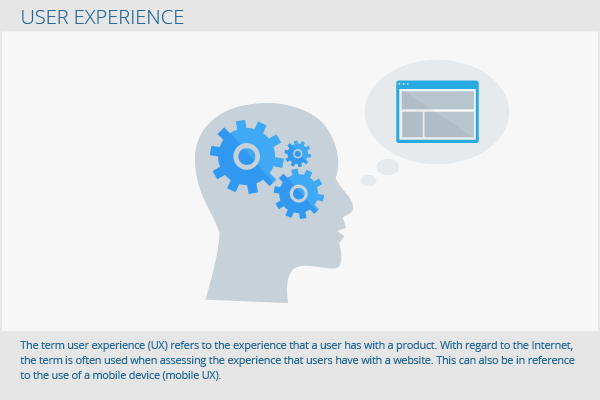User Experience
User experience (UX) refers to the experience that a user has with a product or service. With regard to the Internet, the term is often used when assessing the experience that users have with a website. This can also be in reference to the use of a mobile device (mobile UX).
Elements of the user experience
User experience and usability are often used as synonyms. However, this is partially incorrect since the usability is an element of the user experience. Based on the inspiration of the famous architect, Vitruvius, who first coined the term user experience, a distinction is made between the following elements when reviewing websites:
- Accessibility: adaptation of the website to different devices (e.g., desktop PC, netbook, tablet, smartphone), availability and accessibility scope, loading times
- Aesthetics & beauty: subjective charm or dissatisfaction of the website’s appearance
- Usability: high use of the functions, content, simplicity, and operational efficiency of the website
If one is assessing the user experience of a different product, other aspects can also be used in the place of these three factors. Either way, the factors used should always reflect back on the three basic success factors defined by Vitruvius: strength, utility, and beauty.
User experience as a subjective perception
The type of user experience visitors have on a website is subjectively dependent on their expectations. The experience is either positive or negative depending on what the user wants to achieve. For instance, if the ease of use of the website was promised in an advertisement, two experiences could result. An elderly user, who knows very little about the Internet, would have a negative perception of the website since it is not optimized for this target group. Even when the aesthetics and accessibility are optimal, the website fails in terms of usability. On the other hand, a younger person, who is used to dealing with websites, has a positive experience with the same website.
Assessing the user experience
At first glance, the user experience seems difficult to assess because of its subjectivity. It can however be ascertained and evaluated using different scientific methods. “Hard” factors, such as loading times, availability, or the responsive design, can be determined easily. On the other hand, “soft” factors are a bit more complicated such as the page appearance or the perception in terms of simplicity of the navigation. Here, differentiation methods must be used in order to obtain meaningful values. Among others, the various methods that can be used include:
- Eye tracking: This uses special devices to record the eye movements and glances of the user in order to assess how a website is used. With this method, it becomes possible to identify what was spontaneously caught by the eye and what the user reacted to first.
- Surveys: Surveys can also be used to determine the user experience. The more questions a survey has, the more meaningful the results will be. Surveys that only have one question do not comprehensively reflect on the user experience.
Importance for search engine optimization
The user experience only impacts the search engine optimization of a website indirectly. It is not yet clear if it is actually a ranking factor. Many consider this assertion a pure myth. However, experts believe that the user experience is indirectly reflected on in figures such as the “return to search rate”, dwell time, or returning visitors – all of which can be seen as a quality index in the ranking. As such, search engine optimizers should also optimize the user experience and not completely disregard this aspect.

